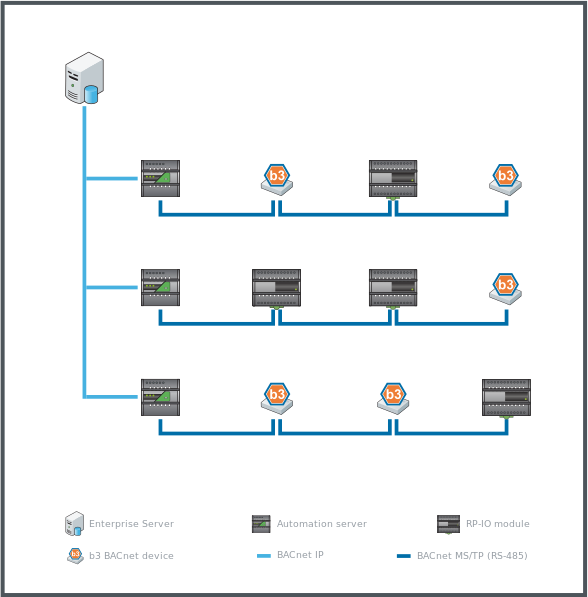
Concepto
RP-IO BACnet MS/TP Support
The RP-IO modules are designed for connection to a BACnet MS/TP (RS-485) network and can only communicate with automation servers using the BACnet MS/TP protocol.
The RP-IO modules have an RS-485 port with a 3-pole removable screw terminal block that is used for connection to the BACnet MS/TP (RS-485) network and MS/TP communication with the automation server (AS-P or AS-B). Connecting to an IP network is not supported as the RP-IO modules do not have Ethernet ports. Para obtener más información, consulte RP-IO Module Communication Port .
You need to configure a unique MS/TP address for the device during installation using the address DIP switches on the device. Para obtener más información, consulte MS/TP DIP Switches .
As part of the commissioning process for the device, you also need to configure the baud rate for the automation server BACnet MS/TP (RS-485) bus. Para obtener más información, consulte MS/TP Communications Baud Rate .

The RP-IO modules can be mixed with b3 BACnet devices on the BACnet MS/TP (RS-485) network. Para obtener más información, consulte RS-485 Communications .
The RP-IO modules are not isolated and connection of the I/O modules to a network comprised of isolated RS-485 interfaces is not recommended. The RS-485 application guidelines provide additional details. Para obtener más información, consulte RS-485 Communications .
A mix of up to 50 devices per RS-485 Com port can be connected to an automation server.

 Hardware Overview
Hardware Overview
 RP-IO Modules
RP-IO Modules
 RP-IO Models
RP-IO Models
 RS-485 Communications
RS-485 Communications
 Wiring
Wiring
 RP-IO Module Communication Port
RP-IO Module Communication Port
 MS/TP Communications Baud Rate
MS/TP Communications Baud Rate
 Configuring MS/TP Network Settings
Configuring MS/TP Network Settings
 MS/TP DIP Switches
MS/TP DIP Switches
 Configuring the MS/TP Address
Configuring the MS/TP Address